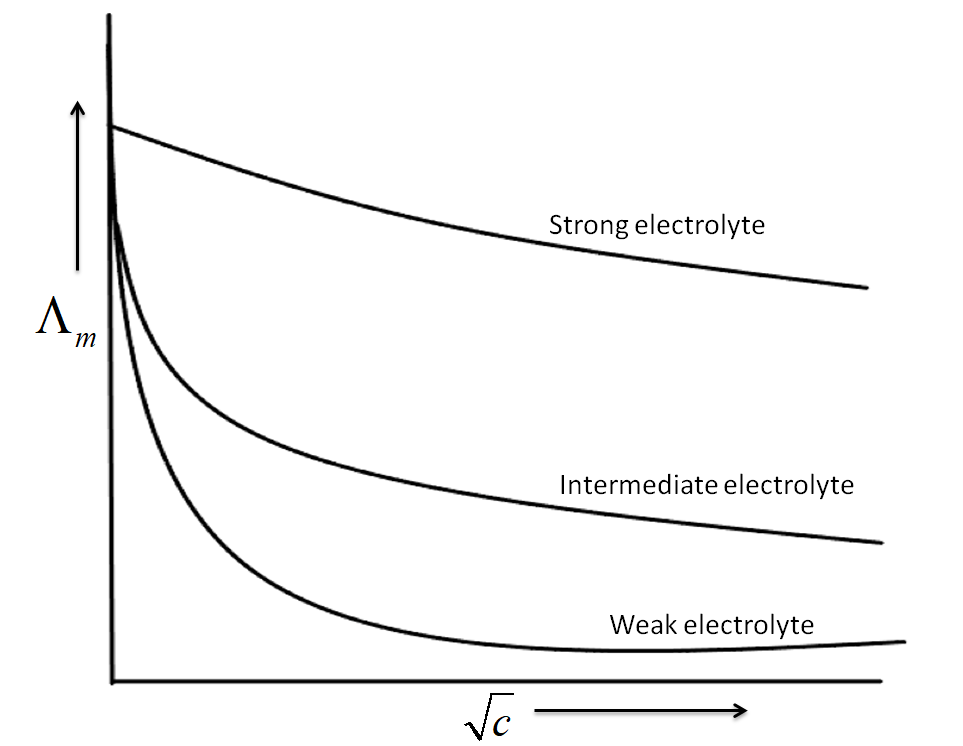
${{\Lambda }^{\infty }}$of strong electrolytes can be obtained by extrapolating $\Lambda $vs $\sqrt{c}$curves to 0 concentration. If true enter 1 else 0.
Answer
574.8k+ views
Hint: Molar conductivity is the conductance property of a solution that contains exactly one mole of the electrolyte or it the function of the ionic strength of a solution or the concentration of the salt present in the solution.
Complete Step by step solution:
-The conducting power of all the ions produced by dissolving one mole of an electrolyte in solution is known as molar conductivity.
-Molar conductivity is represented by the lambda, that is $'\Lambda '$ .
-Molar conductivity is mathematically the conductivity of the solution divided by its molar concentration, that is,
${{\Lambda }_{m}}=\dfrac{k}{c}$
where k = the measured conductivity or the specific conductance
c = molar concentration of the electrolyte
-We can also define the molar conductivity of an electrolyte as the conductance of the electrolyte per volume containing a unit mole of the electrolyte which is placed between two electrodes of unit area cross-section or at a distance of 1cm apart.
-Siemens meter-squared per mole $(S{{m}^{2}}mo{{l}^{-1}})$ the SI unit of molar conductivity.
-For both weak and strong electrolytes, the molar conductivity increases with the decrease in the concentration or with the dilution of the electrolyte. As the increased dilutions lead to the more dissociation of electrolytes which subsequently increases the number of active ions in the solutions and thereby increasing the conductivity.

The graph above clearly shows that for strong electrolytes, the molar conductivity increases slowly with the dilution.
-It ${{E}^{{}^\circ }}$ is the molar conductivity at zero concentration, that is the limiting molar conductivity, the general equation for the plot of the strong electrolyte is given by the Kohlrausch’s law, that is
${{\Lambda }_{m}}=E{}^\circ m-A\sqrt{c}$
where A represents the slope of the plot and depends on the type of electrolyte at a given temperature for a given solvent.
-For strong electrolytes, the increase in the concentration of the electrolyte produces a sharp increase in the conductivity, but at lower concentrations, weak electrolytes give very low values for the specific conductivity, which gradually increases with the increase in concentrations.
Note: The dissociation constant of a weak electrolyte as a function of concentration which is given by Ostwald’s law of dilution is an application of the Molar conductivity, as the dissociation constant can be written in terms of molar conductivity.
Complete Step by step solution:
-The conducting power of all the ions produced by dissolving one mole of an electrolyte in solution is known as molar conductivity.
-Molar conductivity is represented by the lambda, that is $'\Lambda '$ .
-Molar conductivity is mathematically the conductivity of the solution divided by its molar concentration, that is,
${{\Lambda }_{m}}=\dfrac{k}{c}$
where k = the measured conductivity or the specific conductance
c = molar concentration of the electrolyte
-We can also define the molar conductivity of an electrolyte as the conductance of the electrolyte per volume containing a unit mole of the electrolyte which is placed between two electrodes of unit area cross-section or at a distance of 1cm apart.
-Siemens meter-squared per mole $(S{{m}^{2}}mo{{l}^{-1}})$ the SI unit of molar conductivity.
-For both weak and strong electrolytes, the molar conductivity increases with the decrease in the concentration or with the dilution of the electrolyte. As the increased dilutions lead to the more dissociation of electrolytes which subsequently increases the number of active ions in the solutions and thereby increasing the conductivity.

The graph above clearly shows that for strong electrolytes, the molar conductivity increases slowly with the dilution.
-It ${{E}^{{}^\circ }}$ is the molar conductivity at zero concentration, that is the limiting molar conductivity, the general equation for the plot of the strong electrolyte is given by the Kohlrausch’s law, that is
${{\Lambda }_{m}}=E{}^\circ m-A\sqrt{c}$
where A represents the slope of the plot and depends on the type of electrolyte at a given temperature for a given solvent.
-For strong electrolytes, the increase in the concentration of the electrolyte produces a sharp increase in the conductivity, but at lower concentrations, weak electrolytes give very low values for the specific conductivity, which gradually increases with the increase in concentrations.
Note: The dissociation constant of a weak electrolyte as a function of concentration which is given by Ostwald’s law of dilution is an application of the Molar conductivity, as the dissociation constant can be written in terms of molar conductivity.
Recently Updated Pages
A man running at a speed 5 ms is viewed in the side class 12 physics CBSE

The number of solutions in x in 02pi for which sqrt class 12 maths CBSE

State and explain Hardy Weinbergs Principle class 12 biology CBSE

Write any two methods of preparation of phenol Give class 12 chemistry CBSE

Which of the following statements is wrong a Amnion class 12 biology CBSE

Differentiate between action potential and resting class 12 biology CBSE

Trending doubts
What are the major means of transport Explain each class 12 social science CBSE

Which are the Top 10 Largest Countries of the World?

Draw a labelled sketch of the human eye class 12 physics CBSE

Explain sex determination in humans with line diag class 12 biology CBSE

Explain sex determination in humans with the help of class 12 biology CBSE

Differentiate between homogeneous and heterogeneous class 12 chemistry CBSE




